Voted the Best Place to See by Condé Nast Traveler.

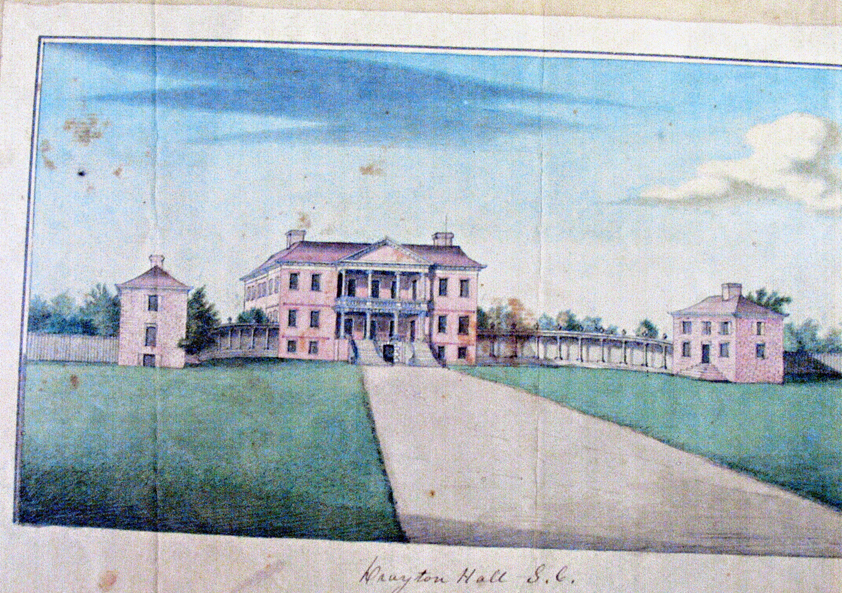
The Mystery Watercolor dated 1765.
Watercolor Mystery Solved! (So Far.)
I’ve been asked to recount the story of the historical detective work that led us to identify the owner of the mysterious watercolor of Drayton Hall, dated 1765, which was sent to us anonymously in September 2007. I’m happy to do so, especially since it means I can acknowledge and thank all the people, including my fellow detectives, who contributed to its success -– because without them, there would be no story.
To begin: in September 2007, I received the copy of the watercolor you see in the image above, purported to be dated 1765. There was no note, and the envelope was simply postmarked Winchester, VA, zip code, 22602-6754. Prior to its arrival, no one had seen such an image of Drayton Hall, nor had the prominent presence of colonnades even been suspected. In fact, no 18th-century image of Drayton Hall had ever been found, the earliest having been dated to c. 1845. But was the watercolor authentic? And who owned it?
To answer the first question, architectural historians and archaeologists have been hard at work, with promising, though not conclusive, results to date.
To answer the second question required historical fieldwork in Winchester itself. Since I’d done similar sleuthing for historical houses for the National Museum of American History, Henry Ford’s Greenfield Village, and other museums, I hoped that what I’d learned could still be of use, so I took up the challenge.
Upon receipt of the copy of the watercolor, I called the post office in Winchester to ask if they could identify the location of the 9-digit zip code, but they politely refused, citing privacy policies. I then followed the first rule of fieldwork: start with who you know. So I called Elizabeth McClung, director of Belle Grove, the National Trust historic site near Winchester, and she advised me to contact Becky Ebert, county archivist, who “knows everybody.”
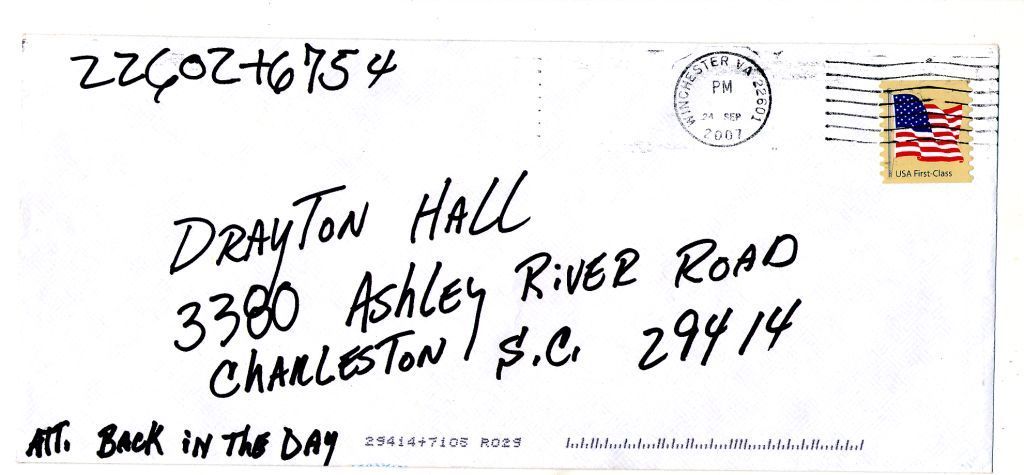
The envelope it was mailed in – postmarked Wincester, VA.
It took me a while, but last April I was in Virginia and called Becky, and drove over to Winchester and met with her. She proved to be quite knowledgeable and tactful, and kindly introduced me to her friends with the post office. Though they were interested in helping Becky and me, the rules for privacy protection still prohibited them from telling us the location of the “6754” of the zip code. They asked me to write a letter, which they might or might not deliver. I did, with Becky’s help, but received no reply.
The mysterious watercolor had aroused so much interest among our staff and others striving to solve this mystery. Among them was Anne Drayton Nelson, daughter of the last owner of Drayton Hall and a devoted friend, who called me in June, saying that a friend of hers had gone online and found that the “6754” referred to Bedford Drive in Winchester. Outstanding! Now we knew where it was -– not a single residence but a street. I “Google-earthed” it and saw it was a short cul de sac in a suburban development. With the street name in hand, Dawn Brogan, my executive assistant and fellow detective, was able to go online and identify the names of each of the Bedford Drive residents.
The opportunity to visit Bedford Drive came in late June because I was in Washington for National Trust meetings. From there I rented a car, drove to Winchester, and the next morning Becky and I headed over. To give credibility and to serve as “leave-behinds”, I carried with me Drayton Hall brochures, copies of our newsletter and of the recent Preservation magazine with the article about Drayton Hall, plus copies of the watercolor itself and my business cards.
When we arrived, I saw a lady walking down to her mailbox, and thanks to Dawn’s list of residents, I knew she was Mrs. Nancy Nettlerodt. So I walked over to her, saying “Hello, Mrs. Nettlerodt, I’m George McDaniel from Charleston, SC, and I’m here trying to solve a history mystery, connecting Winchester to Charleston, and with me is Becky Ebert, county archivist. “ Becky had remained in the car, but when Mrs. Nettelerodt heard her name, she exclaimed, “Oh, I know Becky. I was just with her mother this morning!” So Becky got out, and they hugged, and Becky explained the mystery we were trying to solve.
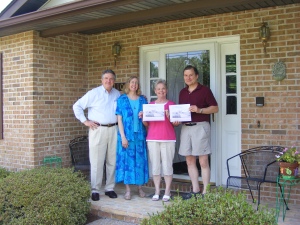
The History Sleuths of Winchester, VA
While Mrs. Nettlerodt didn’t recognize the picture, she was eager to help and introduced Becky and me to her immediate neighbors. None recognized the watercolor, but Blaine Dunn, who lived across the street and who’s very interested in history, offered to take us around to the rest of the neighborhood. He introduced us to Janet Colt and other neighbors, who were intrigued, but unable to identify it. Blaine then volunteered to continue the search since there were a number of neighbors not at home. I gave him copies of my materials to give to them.
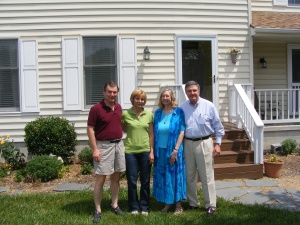
Helpful Bedford Drive Residents
Becky and I then went to the offices of the newspaper The Winchester Star, where Becky had set up an interview with editors Adrian O’Connor and Frances Lowe. Their interests too were piqued by the mystery, and after extensive conversations and reviews of my materials, they volunteered to run a story the next week. I then left Winchester, disappointed in part because we hadn’t found the owner but satisfied that the fieldwork had been complete. I was just going to have to wait.
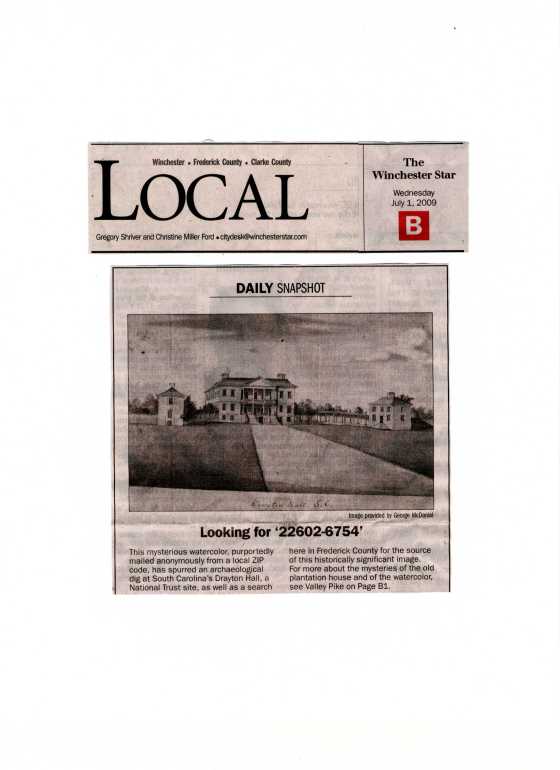
The Winchester Star article by Adrian O’Connor
The next Tuesday, Blaine Dunn called to say that he’d not had success but some good possibilities remained. The next day he called with great news: he’d found the owner! It was one of his neighbors, who had not been at home during the day, and the man wanted me to call him. I did so that night and had a most informative and enjoyable conversation. He wishes to remain anonymous.
On Friday, Becky called to report that Adrian O’Connor had great news. The owner had also responded to the story in the newspaper and had acknowledged to Adrian his ownership of the watercolor. So both fieldwork approaches — the neighborhood search and the newspaper story — had brought results.
In early August, Carter Hudgins, our director of preservation, and I are going up to meet with Becky and the watercolor’s owner. Anne Drayton Nelson, daughter of Charles Drayton, the last owner of Drayton Hall, is going to accompany us since she lives in Montpelier, VA. Matt Webster, former director of preservation at Drayton Hall and now architectural conservator at Colonial Williamsburg, may be joining us. Together we hope to examine the original watercolor and resolve a number of questions: Is it authentic to c. 1765? Are there watermarks or other telltale evidence to support that date? Does the clarity of the original enable historians to discern more clearly clues about the 18th-century site plan and architecture of Drayton Hall? Was, for example, the colonnade a walkway or simply a colonnaded wall or screen, which is what archaeological evidence to date is suggesting.
There will be more to follow, but this concludes the fieldwork phase of the research on the still-mysterious watercolor of Drayton Hall, c. 1765.
– Dr. George W. McDaniel, executive director, Drayton Hall